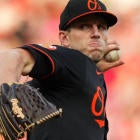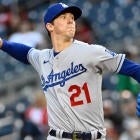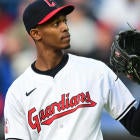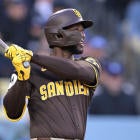Slowly but surely, some of the tasty Statcast details are starting to accumulate, so let's see what we can take from them. Over at BaseballSavant.com, they are keeping track of batted-ball data via MLB Gameday, so let's look at some of the most interesting numbers available.
Note: The batted-ball data on BaseballSavant.com is useful, but seemingly incomplete. For instance, though Joc Pederson is second in baseball in average batted-ball velocity, they only have 21 at-bats worth of data for him. He has put the ball in play in 30 of his 51 at-bats, so they seem to be missing a few games. As a result, this isn't the most scientific data dive possible, but we can at least start to get of what kind of patterns are emerging.
(All stats filtered to include only players with 20-plus at-bats tracked)
The biggest (and smallest) bats
Speaking of Pederson, let's start with the players who lead the majors in average batted-ball velocity: Hanley Ramirez (99.0 MPH), Pederson (97.1 MPH), Alex Rodriguez (97.0 MPH), Jorge Soler (96.5 MPH), Yasmani Grandal (94.9 MPH). And those who come in at the bottom: Billy Hamilton (79.4), Omar Infante (80.6), Matt Joyce (80.7), Johnny Giavotella (81.3), Alberto Callaspo (81.4)
- Grandal probably stands out from the crowd the most here. He was touted as a potential breakout candidate heading into his age-26 season, but is hitting just .217/.345/.326 through 46 at-bats. He has controlled the strike zone very well, but has just a .257 BABIP and only three extra-base hits so far. That last bit can be explained by his 55.6 percent groundball rate and 139.8 average batted ball distance. That puts him in just the 39th percentile of players tracked. Still, the fact that he is hitting the ball so hard bodes well for him finding power at some point.
- Ramirez is an even more paradoxically extreme; he has the hardest tracked batted-ball velocity, but comes in in the 34th percentile in batted ball distance. Ramirez is smoking the ball right now, but even that doesn't mean his 47.1 HR/FB percentage is sustainable. As long as his batted-ball profile remains so heavily weighted toward the groundball side of the ledger, power might be harder to come by than it has been in the past.
- You have to assume Hamilton rates so far below everyone else because of bunt attempts, right? He is not and never will be a power threat, but it seems unlikely he would have less punch in his bat than Omar Infante. Fortunately, he's the type of player for whom this might not be a particularly meaningful stat anyways.
- Matt Joyce's presence does come as a pretty major surprise, given that he clubbed 54 home runs over a three-year span from 2011-2013. However, his power collapsed a year ago, and hasn't recovered so far, and this could explain it. His HR/FB percentage fell from 12.7 percent in 2013 to 7.6 last year, and he has yet to put any of his 20 flyballs over the fence so far.
That Joyce tidbit is a perfect example of why I am so excited for the Statcast data to become more robust. In the past, we generally had to assume that a player's HR/FB would regress to career norms during a down year. However, that was with incomplete information. If we can show that a player is simply hitting the ball less hard, we can take some of the assumptions and guess work that underly a lot of our analysis out of the equation. That's a good thing.
Bomb's Away
What about those players who lead the majors in batted-ball distance? Alex Rodriguez (248.3 feet), Paul Goldschmidt (236.7), Freddie Freeman (220.0), Luis Valbuena (217.2), Jose Bautista (215.9). And the bottom-five: Christian Yelich (59.7), Jose Iglesias (71.1), Starlin Castro (71.9), Rajai Davis (74.7), Everth Cabrera (76.2)
- The leaderboard here doesn't come as much of a surprise, though Rodriguez's presence does bode well given his new approach at the plate. Valbuena's presence is a very pleasant surprise as well, given his hot start. He is an underrated source of potential power, and is worth adding as a corner infielder.
- The good news for Yelich is, he's got an approach that could win him a batting title someday. Especially since he also ranks 28th in averaged batted-ball velocity. Generally speaking, line drives go for hits more often than groundballs, which go for hits more often than fly balls. So, if you're avoiding fly balls, you should be able to sustain a relatively high BABIP, especially with Yelich's speed. So, when he gets back from the DL, we should start to see that average creep up, making him a solid buy-low candidate. However, though he hits the ball hard, he rarely puts it in the air, which puts a ceiling on his power potential even at his young age.
- Like Yelich, we can point to Iglesias' groundball tendencies as one way he can keep his BABIP relatively high. His current .423 mark is obviously unsustainable, but something in the neighborhood of the .356 mark he posted in 2013 could still leave him above .300 if he can sustain the gains in his strikeout rate. He isn't in the same neighborhood as a baserunner, but Iglesias might have some poor man's Jose Altuve in his game.
I suggested that Yelich's profile as a hitter could be made clearer by the Statcast data, so I'm glad to see that hypothesis get some weight behind it.
Stray thoughts
-
Gerardo Parra and Mookie Betts might have more power potential than we've given them credit for. Parra ranks sixth in average batted-ball velocity, and 26th in average batted-ball distance; Betts ranks 11th and 22nd, respectively. Of course, in Parra's case, a breakout seems unlikely with more than 3,000 major-league plate appearances under his belt.
-
Matt Holliday's power loss may be real. He ranks 30th in velocity, but ranks in just the 14th percentile in batted ball distance. He's still a heck of a hitter, and could sustain an average in the high-.200's, but his groundball rate has skyrocketed.
-
Michael Morse and Marcell Ozuna were supposed to provide the power at the heart of the Marlins offense, giving Giancarlo Stanton the kind of protection he has never enjoyed in his career. They have just seven extra-base hits in 127 at-bats between them, and rank 173rd and 175th, respectively, in batted ball distance. However, they both also rank in the top-25 in velocity, making them potential buy-low candidates.
-
Marlon Byrd hit 49 home runs in 2013 and 2014, but that seems like eons ago. He ranks right between Alcides Escobar and Dee Gordon in average velocity, and at 37, might have hit the wall.
-
All Corey Dickerson has done as a professional is hit, and it doesn't all seem to be the Coors Field effect, at least not this season. He has an .821 OPS on the road this season, and Coors isn't responsible for him ranking 21st in average velocity. He is in the midst of his third season in a row in which more than one-fourth of his batted balls have been line drives, and that doesn't seem to be a coincidence.





















